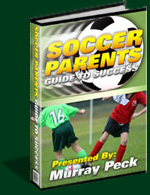Soccer Drills – How To Become A More Aggressive Soccer Player »
By Muz on Dec 31, 2007 in Coaching Youth Soccer, Soccer Drills and Soccer Skills
Practicing [tag-tec]soccer drills[/tag-tec] is a key focus for all of us [tag-tec]coaching youth soccer[/tag-tec]. However, do any of the [tag-tec]soccer drills[/tag-tec] that you apply to soccer training sessions, address aggression? As we all know, [tag-tec]Soccer[/tag-tec] can be a very aggressive sport. I have heard it said that soccer is only for kids who have burly and muscular structures, that is not true. A child may be small, slim and maybe a bit shy but that is not a reason why they should not be playing [tag-tec]soccer[/tag-tec] if they want to.
Some children are naturally aggressive and competitive. This will be an advantage when playing soccer, however it does not mean that a child that demonstrates less aggression cannot participate in this great game. There are a number of [tag-tec]soccer drills[/tag-tec] that can be practiced which will assist the player in overcoming their timid ness.
One [tag-tec]soccer drill[/tag-tec] is called “controlling the air.” Firstly, the [tag-tec]soccer coach[/tag-tec] divides the team in half. The players form two single file lines one behind the other with the opposing teams facing each other. The soccer coach will require a number of training balls ready that can be thrown into the air one at a time. Each player must jump in and fight for control of the ball and get it back to their line. Obviously, no touching the ball with the hands! The player that doesn’t gain control may have to do push ups or sit ups, to be determined by the [tag-tec]soccer coach[/tag-tec]. From a coaching perspective, if more running is required in this soccer drill, players can be moved further apart to increase the distance required to travel.
The second [tag-tec]soccer drill[/tag-tec] is called “protect the ball”. This soccer drill requires a player to buddy up with another player. The first player stands next to a [tag-tec]soccer ball[/tag-tec], with their feet spread about a shoulder width part. The second player stands on the outside shoulder of the first player. The second player must get a touch on the ball. This can be by whatever means the player wants as long as it is with their foot and no fouls are committed. The player with the ball closest to them has to learn to protect the ball and maintain their balance. Each player to switch roles a number of times before the soccer drill is finished.
The final soccer drill is called “I’m closer.” As with the second drill, players buddy up with a partner. This soccer drill is similar to the second except instead of trying to get a touch on the ball, the second player has to force themselves between the first player and the ball. If the first player is forced away from the ball, they then have to work back and try to regain their original position.
It is important to remember, when [tag-tec]coaching youth soccer[/tag-tec], in particular [tag-tec]soccer drills[/tag-tec] that focus on aggression, never let it get out of hand. The coaching point is to ensure the players are going for the ball, not the player. What happens at soccer training is mirrored on the playing field.



















6 Comment(s)
By Ryan on Jul 3, 2008 | Reply
Hi Muz,
You make some interesting points regarding aggression in the game. I am creating a website where people can learn how to improve and was wondering if you’d like to contribute some of your knowledge (and also create a profile for yourself which could help drive visitors back to your blog).
Cheers
– Ryan
By Mr. World on Oct 31, 2008 | Reply
I haven’t read something like this for a long time.
Thanks you for sharing this information!
Mr. World
By Mike on Mar 24, 2010 | Reply
The key to coaching aggression is by making each training session as competitive as possible. Fighting to win the ball will just be a given.
By Muz on Mar 24, 2010 | Reply
Thanks Mike, very good point.
By Wrozbita Marcin on Sep 9, 2010 | Reply
Good info
By football coaching drills on Nov 16, 2010 | Reply
aggression is great in this game abut it needs to be focused but like you say some kids don’t have that in them.